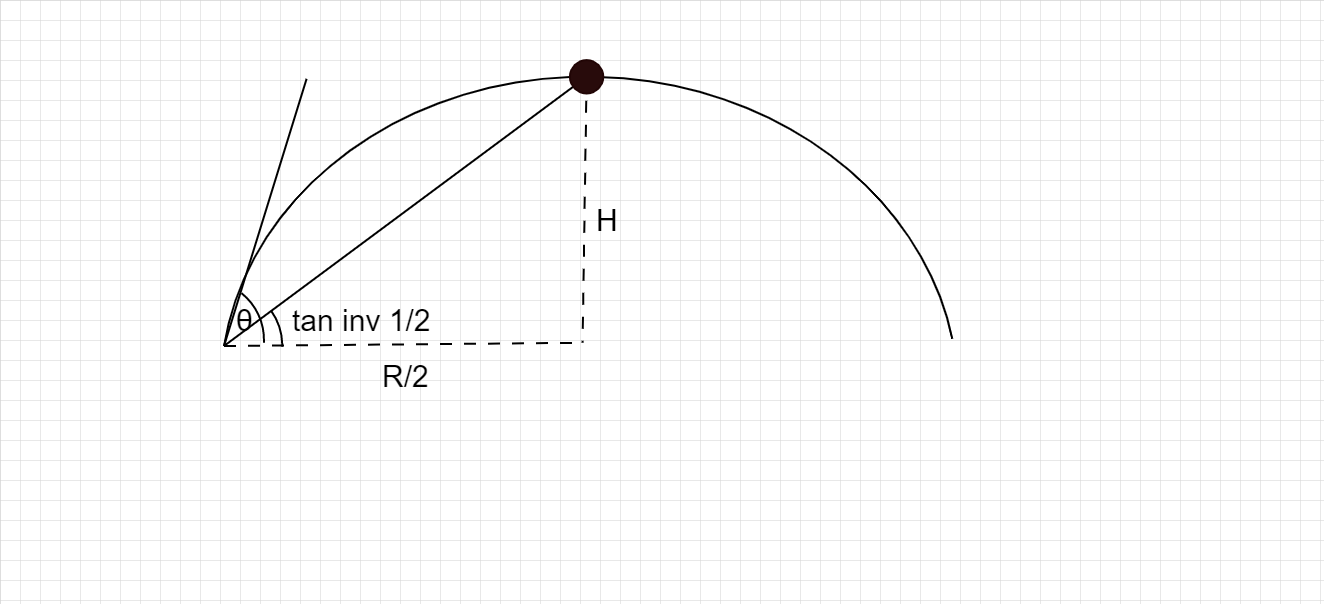
An object is thrown at an angle of $\theta $ with horizontal. If the elevation angle of an object at its highest point as seen from a point of projection is ${\tan ^{ - 1}}\left( {\dfrac{1}{2}} \right)$. Then $\theta $ is equal to:
(A) $30^\circ $
(B) $45^\circ $
(C) $60^\circ $
(D) $37^\circ $
Answer
469.2k+ views
Hint
In the question, it is given that, if the object is observed at an inclination, this angle can be used to determine the range and height. By knowing the relation between range and height, the angle of projection can be found.
$\Rightarrow H = \dfrac{{{U^2}{{\sin }^2}\theta }}{{2g}}$
$\Rightarrow R = \dfrac{{{U^2}2\sin \theta \cos \theta }}{g}$
$\Rightarrow \tan ({\tan ^{ - 1}}x) = x$
Complete step by step answer
When the projectile is thrown, it follows a parabolic path, where it reaches a maximum height equal to-
$\Rightarrow H = \dfrac{{{U^2}{{\sin }^2}\theta }}{{2g}}$
The horizontal distance or range covered during the flight of the projectile, or range is given by-
$\Rightarrow R = \dfrac{{{U^2}2\sin \theta \cos \theta }}{g}$
Here U is the initial velocity of the object
And g is the acceleration due to gravity.
The following diagram makes the question clear-

Thus, we can write-
$\Rightarrow \left( {\dfrac{1}{2}} \right) = \dfrac{H}{{R/2}} = \dfrac{{2H}}{R}$
As, $\left\{ {\tan \left( {{{\tan }^{ - 1}}\dfrac{1}{2}} \right) = \dfrac{1}{2}} \right\}$
Putting the values of H and R,
$\Rightarrow \left( \dfrac{1}{2} \right)=\dfrac{2\left( {}^{{{U}^{2}}{{\operatorname{Sin}}^{2}}\theta }/{}_{2g} \right)}{\left( {}^{2{{U}^{2}}\operatorname{Sin}\theta \cos \theta }/{}_{g} \right)}$
On canceling terms,
$\Rightarrow \left( {\dfrac{1}{2}} \right) = \dfrac{{\sin \theta }}{{2\cos \theta }}$
$\Rightarrow \dfrac{1}{2} \times 2 = \tan \theta $
$\Rightarrow \tan \theta = 1$
So, $\theta = 45^\circ $
Therefore, the correct answer is (B).
Additional Information
In projectile motion, the velocity has two components, horizontal and vertical. The vertical velocity is affected by the gravitational acceleration and thus increases and decreases over the course of the path and also makes the object to reverse its direction, resulting in a maximum height reached.
The horizontal component of velocity however is not affected by any acceleration (except drag force, which can be neglected in ideal cases). This is why the horizontal velocity remains constant throughout the flight, and suddenly becomes zero when the projectile path ends and the object hits the ground.
Note
The horizontal distance of the object from the point of projection should be taken half the value of range because this is the point where the object reaches the maximum height at that height. The equation of the path followed by a projectile is a parabola.
In the question, it is given that, if the object is observed at an inclination, this angle can be used to determine the range and height. By knowing the relation between range and height, the angle of projection can be found.
$\Rightarrow H = \dfrac{{{U^2}{{\sin }^2}\theta }}{{2g}}$
$\Rightarrow R = \dfrac{{{U^2}2\sin \theta \cos \theta }}{g}$
$\Rightarrow \tan ({\tan ^{ - 1}}x) = x$
Complete step by step answer
When the projectile is thrown, it follows a parabolic path, where it reaches a maximum height equal to-
$\Rightarrow H = \dfrac{{{U^2}{{\sin }^2}\theta }}{{2g}}$
The horizontal distance or range covered during the flight of the projectile, or range is given by-
$\Rightarrow R = \dfrac{{{U^2}2\sin \theta \cos \theta }}{g}$
Here U is the initial velocity of the object
And g is the acceleration due to gravity.
The following diagram makes the question clear-

Thus, we can write-
$\Rightarrow \left( {\dfrac{1}{2}} \right) = \dfrac{H}{{R/2}} = \dfrac{{2H}}{R}$
As, $\left\{ {\tan \left( {{{\tan }^{ - 1}}\dfrac{1}{2}} \right) = \dfrac{1}{2}} \right\}$
Putting the values of H and R,
$\Rightarrow \left( \dfrac{1}{2} \right)=\dfrac{2\left( {}^{{{U}^{2}}{{\operatorname{Sin}}^{2}}\theta }/{}_{2g} \right)}{\left( {}^{2{{U}^{2}}\operatorname{Sin}\theta \cos \theta }/{}_{g} \right)}$
On canceling terms,
$\Rightarrow \left( {\dfrac{1}{2}} \right) = \dfrac{{\sin \theta }}{{2\cos \theta }}$
$\Rightarrow \dfrac{1}{2} \times 2 = \tan \theta $
$\Rightarrow \tan \theta = 1$
So, $\theta = 45^\circ $
Therefore, the correct answer is (B).
Additional Information
In projectile motion, the velocity has two components, horizontal and vertical. The vertical velocity is affected by the gravitational acceleration and thus increases and decreases over the course of the path and also makes the object to reverse its direction, resulting in a maximum height reached.
The horizontal component of velocity however is not affected by any acceleration (except drag force, which can be neglected in ideal cases). This is why the horizontal velocity remains constant throughout the flight, and suddenly becomes zero when the projectile path ends and the object hits the ground.
Note
The horizontal distance of the object from the point of projection should be taken half the value of range because this is the point where the object reaches the maximum height at that height. The equation of the path followed by a projectile is a parabola.
Recently Updated Pages
Master Class 11 Accountancy: Engaging Questions & Answers for Success

Glucose when reduced with HI and red Phosphorus gives class 11 chemistry CBSE

The highest possible oxidation states of Uranium and class 11 chemistry CBSE

Find the value of x if the mode of the following data class 11 maths CBSE

Which of the following can be used in the Friedel Crafts class 11 chemistry CBSE

A sphere of mass 40 kg is attracted by a second sphere class 11 physics CBSE

Trending doubts
One Metric ton is equal to kg A 10000 B 1000 C 100 class 11 physics CBSE

What organs are located on the left side of your body class 11 biology CBSE

Soap bubble appears coloured due to the phenomenon class 11 physics CBSE

How is the brain protected from injury and shock class 11 biology CBSE

Define least count of vernier callipers How do you class 11 physics CBSE

What is Environment class 11 chemistry CBSE




